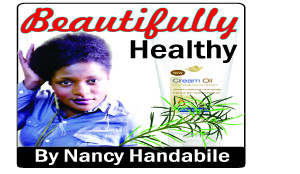 “What do you use in your hair?” This is a question I get a lot before launching into a long explanation which I don’t really mind but I always hasten to advise that you must find your niche, your oil.
“What do you use in your hair?” This is a question I get a lot before launching into a long explanation which I don’t really mind but I always hasten to advise that you must find your niche, your oil.
When I first became a naturalist, I was a product ‘junkie’, I used anything and everything that someone claimed worked and yes it worked for them.
Our hair patterns are different, as our regimens are, hence the need to discover what works for us individually. Otherwise you will keep thinking that many products don’t work or that your hair is difficult to maintain (which is not true).
Now I am not an expert though I can attest that I am really good at using Uncle Google through the Internet for some information.
This will be a three-part series so that by the end of it you will have an extensive or at least close to extensive knowledge.
The first thing you need to know according to Blackgirllonghair.com is that fat in oil is divided into two, that is saturated and unsaturated (which has two main sub-categories of polyunsaturated and monounsaturated).
I bet you wish you had paid attention in sciences now.
The site further explains; “Saturated oils with a high fatty acid content (i.e. stearic, lauric and palmitic acids) or high monounsaturated fatty acid content (i.e. oleic acid) tend to have an easier time “becoming one” with our hair fibres because of their simple, straight chain structure that allows for easy entry into the deepest layers of the strand.
Coconut oil is very high in saturated fat. Oils high in monounsaturated fat include avocado oil, jojoba oil, olive oil and sweet almond oil.”
The oils with high poly-unsaturated fatty acid content (i.e. linoleic, linolic acid) have the tendency to penetrate only the most outer layers and coat the cuticle of the hair.
“This is excellent for providing shine and keeping hair tangle free. Oils high in polyunsaturated fat include castor oil, flaxseed oil and grape seed oil.”
Ok now you know so how do you then go about trying to find oil that works for you.
You need to ask yourself certain questions.
What’s your hairs porosity like?
Here is how you can test your hair’s porosity and its ability to absorb and hold moisture.
Here’s a test called the float test which I found on naturallycurly.com: “Take a couple of strands of hair from your comb or brush and drop them into a bowl of water. Let them sit for 2-4 minutes. If your hair floats, you have low porosity. If it sinks, you have high porosity.” The lower your hair porosity the healthier your hair is.
So in regards to this; Hair that is very porous easily absorbs almost anything you place on it. However from my experience it also shrinks really fast and really badly.
Try and add more unsaturated oils to help, same if your primary goals are for shine and gloss.
If your main aim is oils that will condition and penetrate your hair shafts in the long run strengthening them the go for saturated oils.
My personal advice is to mix and match and add more of what type you need.
Of course the diagram below will also help you decipher it out or email me at divadiarys@gmail.com or head over to my blog for some links and more information divadiarys.blogspot.com.
That said lets interact more on social media be it twitter or Instagram @Arushapot and also on Facebook.
See you next week when we discuss different types of oil. Stay beautifully healthy this week.






